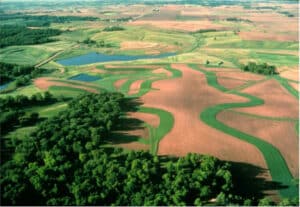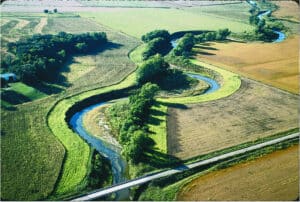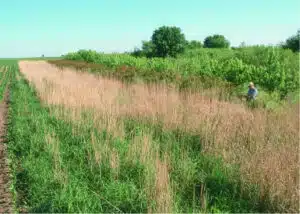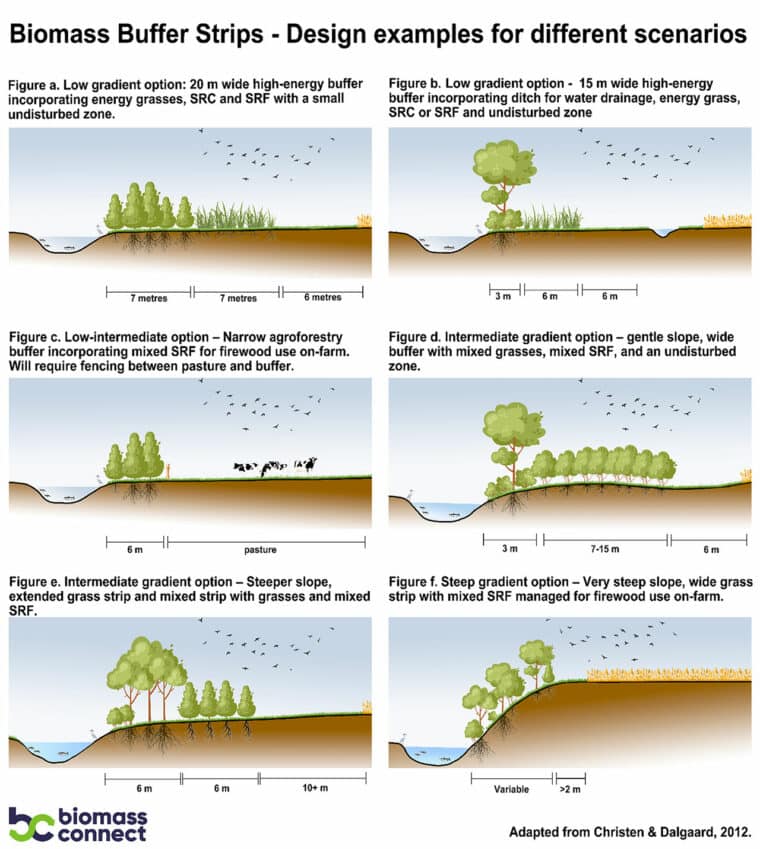Biomass Buffer Strips – using biomass crops in multipurpose land management
Key messages:
- Buffer strips provide an effective land management option to reduce flood risk, soil erosion, and groundwater pollution from agricultural land.
- Buffer strips consist of planting strips of either grasses, other herbaceous perennials or tree species in 6-20 m wide strips along field margins or beside watercourses.
- Perennial biomass crops such as energy grasses (e.g. miscanthus, switchgrass, reed canary grass) and short-rotation trees (e.g. willow coppice and poplar) can all be used to create buffer strips. Their suitability needs to be matched to the buffer functions required, the site conditions, and planting location.
- For harvesting biomass, site logistics such as access and operating space for harvesting machinery needs to be considered in planning the locations of biomass buffer strips.
Introduction
A buffer strip is an area of land which is either left uncultivated or planted with perennial grasses, shrubs and trees. Planting strips or alleys of perennial biomass crops on existing agricultural land can provide a number of important benefits in terms of flood management, soil recovery and improvements in biodiversity, in addition to providing a harvestable resource. Wider adoption could help better manage landscapes to be more resilient to the effects of climate change, mitigate flood risk, and reduce the environmental impacts of intensive agriculture.
How are buffer strips used?
Buffer strips have been proven to be effective at reducing soil erosion, leaching and run-off of agricultural chemicals which is known to result in pollution of watercourses.
Perennial buffer strips planted adjacent to arable land have been shown to reduce soil sediment, nutrient loss, and pesticide drift while improving soil health and farmland biodiversity. Agroforestry systems have also been shown to provide effective windbreaks, provide wildlife corridors that can connect fragmented habitats and can also enhance the natural regulation of pests. Provided the biomass crops can be safely and effectively harvested, their inclusion in buffer zones adds value by providing an additional harvestable resource which requires little or no maintenance. The biomass crops can make use of nutrient run-off, providing higher biomass yields while simultaneously reducing the nutrient load entering water courses which is a major source of pollution.
Broadly speaking, based on their location, buffer strips fall into one of two categories:
- In-field strips – across the slope of the field, along land contours and field margins.
- Riparian strips – flanking the banks of watercourses.
- Buffer Strips
- Riparian Buffer Zones
The current Environmental Land Management (ELM) scheme in England supports the adoption of buffer strips and there are woodland grants and incentives available for establishing and maintaining woodland for nature recovery, riparian buffers, improving water quality and reducing flood risk but biomass crops and short-rotation forestry (<8 yr rotation) are not currently eligible under current rules.
Use of buffer strips was piloted under the Catchment Sensitive Farming partnership, co-ordinated by Natural England and the Environment Agency, 3836 riparian buffer strips were established on participating farms in England between 2006-2018 and proved a popular measure, with 1 in 6 farms adopting their use. In-field and riparian buffer strips were both within the top-five most impactful catchment-sensitive farming measures identified. Use of biomass crops in buffer strips has great potential, but their adoption has so far been limited.
The main functions of buffer strips.
The main functions of buffer strips can be summarised as: Natural flood management, nutrient and pollution control, protection of soils and nature conservation.
Natural flood management – Buffer strips containing tall grasses, trees or shrubs act as a physical barrier which slows the run-off of surface water following heavy rains making them effective natural flood management strategies which are likely to be of growing importance. Buffer strips can help achieve this by acting in the following ways:
- Increasing the interception of rainfall – leaves catch rain before it reaches the ground slowing the rate of flow and allowing a proportion of the rainfall to evaporate from the leaf surface.
- Slowing the flow of surface water – above-ground vegetation provides a physical barrier which slows the flow of water running off the soil surface.
- Increasing absorption of water into the soil – Established buffer strips can improve soil structure allowing water to penetrate deeper into the soil, increasing the volume that can be stored in the soil and reduce the likelihood of saturation which leads to greater run-off.
- Larger perennial crops and tree species take up significant quantities of water from the soil, can help reduce soil saturation and ameliorate areas prone to waterlogging. Conversely, in drier conditions, buffers can also help to conserve soil moisture and reduce effects of drought.
Pollution control – In areas where agricultural land is more intensively managed, nitrate-N (NO3–) and phosphorous (P) leaching and run-off is known to be a main source of pollution resulting in eutrophication of lakes and waterways. Deep rooting perennial plants and tree species can act as a biological filter which take up and utilise nutrients before they enter watercourses. Studies have shown that riparian buffers can remove between 30-99% of nitrate and 20-100% of phosphorous depending on site conditions and the buffer composition, with combinations of grasses and trees tending to be most effective. In situations where frequent incidences of fertiliser run-off are common, some riparian buffers have been shown to reach saturation after a few years if the biomass is not regularly removed. For this reason, using biomass crops in buffers provides an added benefit as the leaching fertiliser can result in higher harvestable yields of biomass and also help maintain the effectiveness of the buffer strip in terms of N and P uptake. In addition to nutrient run-off, buffer strips can also be effective for wastewater management. Biomass crops such as willow short-rotation coppice have been shown to be particularly effective, permanent nutrient removal of 55 kg PO43−eq ha yr has been reported based on field trials conducted in Northern Ireland.
Pesticides are another potential source of pollution from agricultural practice. The pesticides applied in the UK have a wide range of different properties and modes of action, but in general most pesticides will preferentially adsorb to dead organic material such as leaf litter. Incorporation of tall, dense and fast-growing species in the buffer strip can also act as a windbreak or shelter belt which can create a physical barrier to prevent pesticide drift. Biomass crops which create deep leaf litter layers before the biomass is harvested, such as miscanthus and willow, may also be particularly effective if protection from fertiliser run-off and pesticide drift are both required. Poplar and willow have been shown to take up and immobilise a wide range of pollutants, including pesticides.
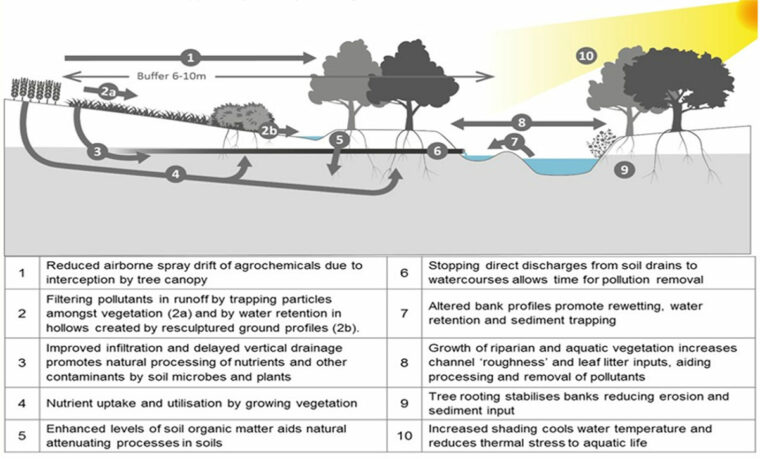
Source: Environment Agency (2020). 3D buffer strips: Designed to deliver more for the environment. Environment Agency, Bristol.
Soil health – The above ground vegetation of the buffer strip helps catch and retain soil that has been eroded by wind or water. On degraded arable soils, uncultivated buffer strips will also allow the soil to recover over time. Deep rooting plants can help stabilise soils at higher risk of erosion, such as riverbanks and areas around water bodies, often collectively referred to as riparian zones.
Buffer strips have also been shown to enhance soil carbon through sequestration, root turnover, leaf litter, and simply by leaving the area unploughed for a prolonged period which allows the soil time to recover and reduces incidences of soil compaction. The total carbon stocks under short rotation forestry have been reported as 1.5 times higher than alternative land uses when planted on agricultural land.
Nature conservation – Biodiversity and wildlife corridors – Buffer strips provide important habitats and can provide cover for wildlife to allow them to move freely between different habitats which are often fragmented by field boundaries. Tall grass and tree species incorporated into buffer strips also provide shade which can be of benefit to aquatic life in water courses. Perennial biomass crops also provide important winter cover. As they are harvested in late winter, they provide vegetative cover when adjacent agricultural land is often bare which also poses even greater risk of flooding and erosion.
Perennial biomass crops best suited to use in buffer strips
A number of different biomass crops may be suitable for use in buffer strips. Perennial grasses bred specifically for high-yield and energy content are one option. Stiff-stemmed grassland species that are resistant to high run-off rates are most suitable and can be selected as a feedstock for multiple purposes: Combustion, anaerobic digestion, forage/grazing or animal bedding. Wildflower mixtures are also an option for inclusion. Some energy grasses, such as miscanthus, may require a minimum planting area and an established local market in order to be economically viable to harvest on smaller scales, unless used on-farm as animal bedding.
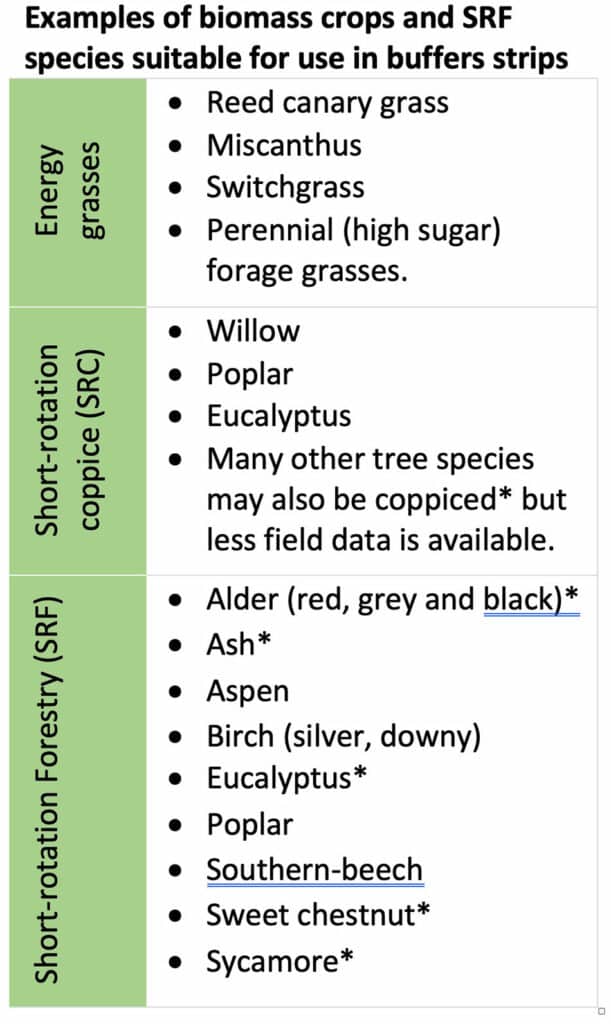 Short-rotation coppice (SRC), e.g. tree species such as willow and poplar, which are cut to a low stump (stool) and produce multiple stems that are harvested every 2-5 years, are also an option where land is not too steep. Alternatively, short-rotation forestry (SRF) may be suitable. SRF uses high-yielding tree species grown at high stocking densities for 8-20 year rotations. Wood is harvested when stems reach approximately 20cm diameter. If space permits, conventional woodland management of wooded buffer zones is a long-term option.
Short-rotation coppice (SRC), e.g. tree species such as willow and poplar, which are cut to a low stump (stool) and produce multiple stems that are harvested every 2-5 years, are also an option where land is not too steep. Alternatively, short-rotation forestry (SRF) may be suitable. SRF uses high-yielding tree species grown at high stocking densities for 8-20 year rotations. Wood is harvested when stems reach approximately 20cm diameter. If space permits, conventional woodland management of wooded buffer zones is a long-term option.
Types of buffer strip
In terms of composition, buffers can be classed as: Vegetated, incorporating grasses and wildflower species; Wooded, incorporating tree and shrub species; or integrated/engineered, incorporating a mixture of species and/or earthworks. Integrated or engineered buffer strips are recommended as the best designs for incorporating biomass crop species. With reference to riparian buffer strips, a three-zone structure has been recommended as most effective for use with biomass crops:
- Grass strip – This strip reduces the flow rate of surface run-off, filters sediment and reduces erosion. Nutrients are taken up by the plants during the growing season. The strip may be composed of any perennial grasses, including energy grasses. Depending on the grass used, the strip can also be used for extensive grazing, silage/hay production, animal bedding, or for bioenergy.
- Woodland strip – This strip improves interception of rainfall, deep rooting tree species help stabilise banks and filter nutrient and pollutant run-off via uptake and immobilisation in the biomass. Taller species also act as windbreak and prevent erosion and pesticide drift. This strip can be composed of mixtures of short-rotation coppice (SRC) or short-rotation forestry species (SRF). The harvested biomass can be chipped or cut as billets for firewood.
- Undisturbed strip – helps to protect planted strips during flooding events, reduces bank erosion and provides a buffer between planted biomass crops and water courses to allow space for harvesting and maintenance operations.
Slope can be used as one of the key considerations for planning a biomass buffer
| Low gradient |
|
Intermediate gradient
|
|
Steep Gradient
|
|
Other considerations
Depending on where buffers are located, existing land drains can negate the effects of buffer strips due to providing a bypass for surface water run-off. In cases where extensive networks of land drains are already present, redirecting flow to a drainage ditch between the field and the buffer could provide a solution. Where this is not possible, a constructed wetland area could be another option for environmental protection and conservation.
The greater the level of engineering that goes into buffer strips, the greater the cost, but also the greater the benefit. Planning needs to take account of biomass crop establishment and harvesting requirements both in terms of cost and management considerations.
Where livestock are also present, or in areas where browsing damage from rabbits/deer is a problem, fencing may be required to prevent grazing of establishing buffer strips and to keep livestock away from water courses.
Biomass Connect Media:
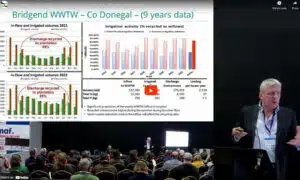 Dr Chris Johnston of the Agri-Food and Biosciences Institute (AFBI), a Biomass Connect partner, gave talk at the UK Low Carbon Agriculture Show, February 2023, showing results of field trials into the effectiveness of short-rotation coppice willow for environmental protection and wastewater management.
Dr Chris Johnston of the Agri-Food and Biosciences Institute (AFBI), a Biomass Connect partner, gave talk at the UK Low Carbon Agriculture Show, February 2023, showing results of field trials into the effectiveness of short-rotation coppice willow for environmental protection and wastewater management.
Current UK policy
The current Environmental Land Management (ELM) scheme in England supports the adoption of buffer strips and there are woodland grants and incentives available for establishing and maintaining woodland for nature recovery, riparian buffers, improving water quality and reducing flood risk. Biomass crops and short-rotation forestry, with rotation length less than 8 years, are not yet eligible for ELMs or woodland creation (EWCO) incentives.
Conclusion – Main considerations when establishing biomass buffer strips.
The optimum design, composition and width of a buffer strip depends on a wide range of factors which include:
- The environmental and conservation issues being addressed.
- The previous and adjacent land use.
- The soil type and condition.
- The slope, topography and hydrology of the site.
- The desired biomass products and yields.
- Harvesting technology required and local markets available for the biomass.
- Cost of measures required and government payments available to support their use.
Further information:
Related Biomass Connect Articles:
How does Short Rotation Coppice (SRC) willow affect biodiversity?
What effect does planting biomass crops have on soil carbon?
Other resources:
Funding for landowners – Nature based solutions to reduce flood risk
Examples and case studies – How nature-based solutions can mitigate flood risk.
Riparian forest management on freshwater environment – Best management practice guide.
Natural Flood Management Handbook – A practical guide for farmers.
